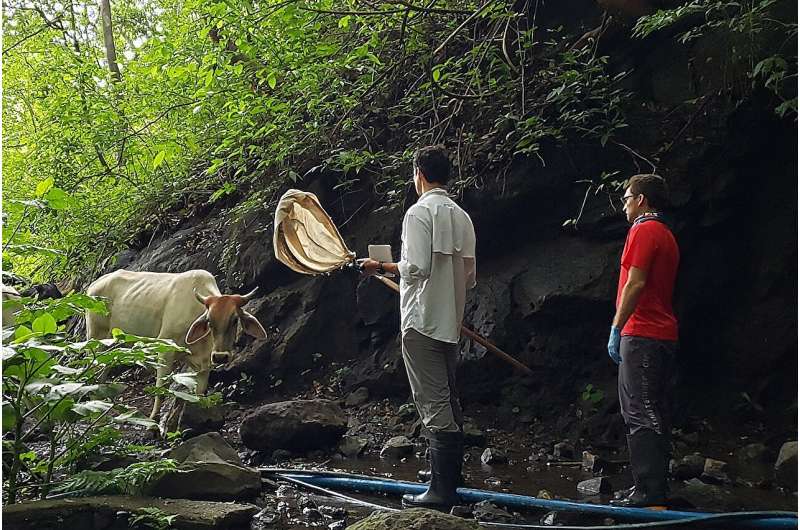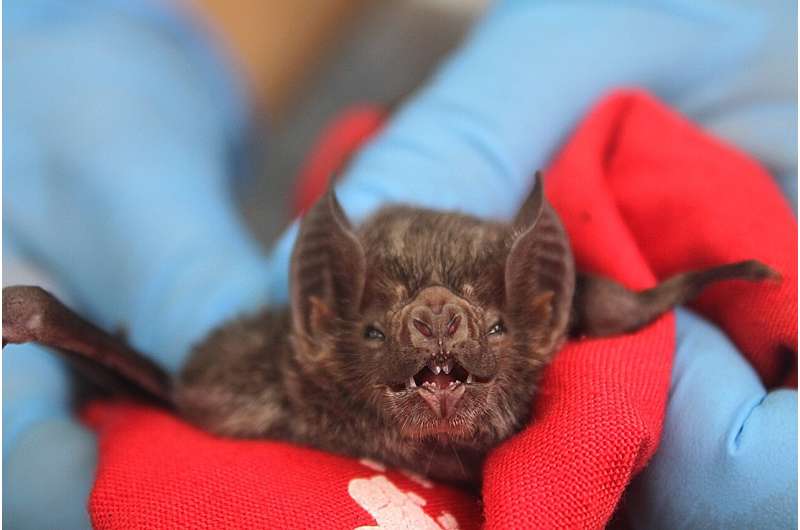This article has been reviewed according to Science X's editorial process and policies. Editors have highlighted the following attributes while ensuring the content's credibility:
fact-checked
peer-reviewed publication
trusted source
proofread
Rabies outbreaks in Costa Rica cattle linked to deforestation

Deforestation in Costa Rica raises the risk of cattle becoming infected with rabies by vampire bats, finds a new study. Emerging Infectious Diseases published the research by disease ecologists at Emory University.
"A healthy tropical forest has phenomenal diversity—not just among plants and mammals like monkeys and bats, but also among microorganisms," says Thomas Gillespie, Emory professor and chair of the Department of Environmental Sciences and senior author of the study.
"When you destroy parts of a forest, the diversity goes down and the dynamics of disease transmission may change in a way that leads to the emergence of new pathogens or the reemergence of existing ones."
The Costa Rica economy relies heavily on ecotourism. Approximately 25% of its territory is protected under its National System of Conservation Areas, the largest percentage of protected areas accounted for by any country in the world, according to the Global Alliance of National Parks.
Agriculture, however, is also an important economic sector and often encroaches into unprotected tropical forest areas. Livestock farms cover about 38% of the country's territory, according to the United Nations Environment Program.
"The government has done an amazing job of protecting much of its tropical forest," Gillespie says. "In some areas, however, the country has high rates of deforestation due to clearing of the land for agricultural uses. It's a big dichotomy."
Rabies is a viral disease most often transmitted by the bite of a rabid mammal. Vaccination campaigns have been largely effective at preventing rabies outbreaks in dogs in Costa Rica. The virus, though, keeps reemerging in cattle, spread by vampire bats.
Found in tropical and subtropical areas of Central and South America, vampire bats feed solely on blood. Unlike other bats, they can walk—and even run—on land. They feed at night, stealthily approaching a sleeping mammal.
Razor-sharp teeth and surgical precision allow the bats to make an incision in an animal, such as in the hock of a cow, without the animal feeling it. An anticoagulant in vampire bat saliva keeps the blood flowing as the bat laps up a meal.
The researchers wanted to better understand the factors associated with rabies outbreaks in cattle in Costa Rica.
They drew from data of the National Animal Health Service of Costa Rica to map the time and locations of rabies outbreaks in cattle from 1985 to 2020 in both northern and southern regions of the country where tropical forest has been cleared for agriculture.
They also mapped land-use data across the same time for the outbreak sites, including a radius of 10 kilometers for each site, the maximum foraging range for vampire bats.

They then used geographic information system software to generate spatial probability estimations based on these known outbreaks.
The results showed a link between the location of forest habitat and an outbreak. Each one-kilometer increase in distance from forest increased the probability of an outbreak by 4%.
The researchers theorize that decreased availability of bat-roosting sites within forested habitat appears to increase the preference of vampire bats to feed on cattle, as opposed to wild mammals.
"We found the highest probability of rabies outbreaks in Puntarenas Province in the south, indicating the need for localized, preventative interventions in that region to avoid rabies reemergence in people," says Julie Clennon, an eco-epidemiologist in Emory's Department of Environmental Sciences and co-author of the study.
A growing number of studies show a similar pattern linking the destruction of tropical forests with disease reemergence, Gillespie says, including a reemergence of hanta viruses in the Amazon associated with soybean production and the reemergence of the Lassa virus in West Africa, linked to oil-palm production.
In a previous study, the researchers and colleagues showed that shifts in the feeding preferences of vampire bats due to human land-use changes in Costa Rica altered the gut microbial communities and immune systems of the bats. Such shifts could potentially make bats more susceptible to pathogens and more likely to spread them.
"When governments make decisions about large-scale land-use changes, they need to consider the potential of disease emergence, or reemergence, along with the potential for increased greenhouse-gas emissions," Gillespie says.
In addition to their association with the destruction of natural habitat, cows and other ruminant animals emit methane, a potent greenhouse gas, as they digest grasses. And the greenhouse gas nitrous oxide is emitted from the manure of ruminants.
"As an individual, you may want to reduce beef in your diet as much as possible," Gillespie says, "both to improve your own health and that of the planet. We are currently using natural resources at a rate that's not sustainable."
First author of the current paper is Christie Jones, who did the work as a student in Emory's 4+1 BS/MPH program, where she received a bachelor's degree in environmental sciences before entering an accelerated program for a master's of public health at Rollins School of Public Health. Jones is currently studying medicine at the American University of the Caribbean.
More information: Christie Jones et al, Deforestation and Bovine Rabies Outbreaks in Costa Rica, 1985–2020, Emerging Infectious Diseases (2024). DOI: 10.3201/eid3005.230927
Journal information: Emerging Infectious Diseases
Provided by Emory University


















